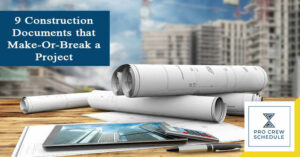In construction, there are many types of documents you’ll come across. Still, there are only a few essential documents that you need to have for your projects, regardless if it’s a 10-storey residential or a commercial complex.
This set of core documents will keep you on top of your project and guide you through the construction process, from planning to close-out. Having 24/7 access to these documents puts information available to the right people at the right time. Therefore, decisions can be made quicker, and action can be taken faster to finish projects within scope and on time.
First order of business, let’s answer – what are construction documents?
What are Construction Documents, and Why is it Critical?
Construction documents serve several purposes, including construction inventory management, project tracking, documenting changes, covering daily information, permit applications, and more. These documents cover your business operations in general from the start of a project until the end.
Some of the most common construction documents you’ll find in a project are the following:
- Daily construction reports
- Request for Approval (RFA)
- Request for Information (RFI)
- Notice to Proceed (NTP)
- Work Order
- Safety Reports
- Bidding Proposals
Are Construction Documents Different from Construction Contracts?
Construction contracts or agreements are technically construction documents that serve different purposes. You’ll encounter many construction contract documents as you work on your projects. The construction industry uses various contracts depending on the project’s scope, schedule, delivery, budget, and all the necessary parties involved.
Knowing what type of contract to use when is vital to ensuring a successful delivery outcome, customer satisfaction, and overall profit.
Here is a compilation of the construction documents you should understand and use consistently for all your projects. The following are the most important and common construction project documents.
1. Construction Documents
A construction project will not start without drawings for all trades. These visual files show the final design and allow the contractor and customer to review and agree on the final look of the project before work even begins.
2. General Specifications
A construction project specification shows the technical details of any project. Most commonly known as “specs,” these documents will cover information such as the following:
- Equipment and Tools: what is expected to be used
- Methodology: how to commence plans
- Standard material specs or deviations, if any
- Construction task management: effective and efficient practices
- Testing and Commissioning: certifications are needed before the project close-out
3. Bill of Quantities (BOQ)
To keep an efficient construction inventory management to track all tools and materials for a project, a bill of quantities (sometimes known as a bill of materials in some countries) is essential. This is a detailed list of all the materials, labor, equipment, tools, and parts used in the project operation. Pricing for each item in this list is also included in the BOQ.
A bill of quantities helps contractors and subcontractors estimate how much a project will cost, so they can offer accurate bids for award. Clients can also benefit from this document since they can see an itemized breakdown with a breakdown of where their money has been spent.
4. Scope of Work (SOW)
For any construction project, you must understand the scope before any work starts. The scope of work details everything that needs to be done to complete a construction project.
With a good scope of work, the details about the project will be made clearer, so it’s easier to come up with a project timeline and other conditions made specifically for that specific project.
Scope of work may also cover information on construction workforce management: who will complete certain job scope and what materials will be used to get it done.
5. General Conditions
The general conditions document simply covers the contractor’s project obligations. It goes over the legal contract framework and details how you can resolve potential problems or disputes you may encounter during the construction process.
6. Special Conditions
Special conditions document, on the other hand, goes over any part of the project with special instructions that don’t necessarily apply to the rest of the project. This document is an extension of the general conditions document.
7. Cost Estimate
Cost estimate helps in identifying the soft and hard costs involved in the project. This type of estimate may show a lump sum, or it can be broken down into sections.
Hard costs have to be added the following:
- Project timeline: when is the work target to be completed
- Labor estimates: total workforce hours and cost
- Overhead cost: indirect costs involved in a project
- Landscaping cost: for project beautification
- Contingencies: typically 10% of the total project cost
As for the soft costs involved in the project:
- Inflation: mostly depends on the location and year
- Equipment and Tools: what is needed during operations
- Inspection Fees: for permits, testing, and commission
Typically, hard costs make up 70% of the overall budget, while soft costs make up 30%.
8. Schedule of Values
In construction, a schedule of values is a vital document that goes over each job item on a specific project, and this document also includes the cost of each item.
When a client is uncertain about how much a project costs, Value Engineering (VE) is sometimes done to get the schedule of values with the minimal cost to deliver the project on time.
9. Construction Schedule
No construction project will start without a schedule in place.
A construction schedule is a make or break of any project since it helps keep the project on track and completed on an approximate timeline. However, schedules must be flexible; some job scope will have the potential for delays, so options to alter the schedule is necessary for construction operations.
For instance, most residential projects will need a myriad of permits before starting, and with eternal factors such as local government conditions and additional requirements, delays are to be expected. The construction schedule may include steps on what to do when these delays occur and what actions to take if permits and materials are not secured as expected.
A good schedule will go over each component needed for the project, such as construction crew scheduling, task management, and inventory management. Fortunately, construction management software is now available to make project scheduling a breeze.
10. Construction Contracts or Agreements
A construction agreement goes over the detailed scope of work that is needed to be done on a construction project. It will delve into information such as:
- Construction Workforce Management: who will do the specific job scope
- Scope of Work
- General Specification
- Supplier Information
- General Timeline and Schedule
- Payment Information – who pays for what
- Provision for potential delays
- Provision for issues and disputes
- Contractor protections
- Insurance
- Local contract conditions and laws
- Claims processing
This basic agreement has to be signed by all parties involved before any work can begin.
Some of the most commonly used construction contracts in the industry are as follows:
a. Unit Price Contract
b. Time and Materials Contract
c. Lump-Sum Contract
d. Integrated Project Delivery Contract
e. Incentive Construction Contracts
f. Guaranteed Maximum Price Contract
g. Design-Build Contract
e. Cost-Plus Contract
How to Optimize Your Construction Document Workflow
It is helpful to have all of the construction documents discussed available, so you and your team can search for data easily and quickly. However, we know how time-consuming it is for construction professionals to manage documents manually- it can also be overwhelming and daunting to some.
Fortunately, new technology can help keep construction documents organized, helping centralize your construction data to make it available for your team wherever and whenever you need it.
Adapting Construction Management Software for Better Document Control
One of the best ways to organize all your construction data is by centralizing it in one place. It is most helpful when finding and analyzing your data is easy. When data is inaccessible and hard to find, big decisions may need to be made with less information, increasing the risk of errors on a construction project.
Adapting the right technology to centralize your construction data can help you establish optimized workflows that are both streamlined and standardized. You can establish the most optimal workflow for your team by asking basic questions such as, who needs to review and approve certain changes, and who can access or edit data in this new system.
A centralized data environment, such as Pro Crew Schedule, facilitates collaboration and helps your team avoid lost data and time. This software is also available online, meaning you can access your data in the office, on-site, or anywhere.







